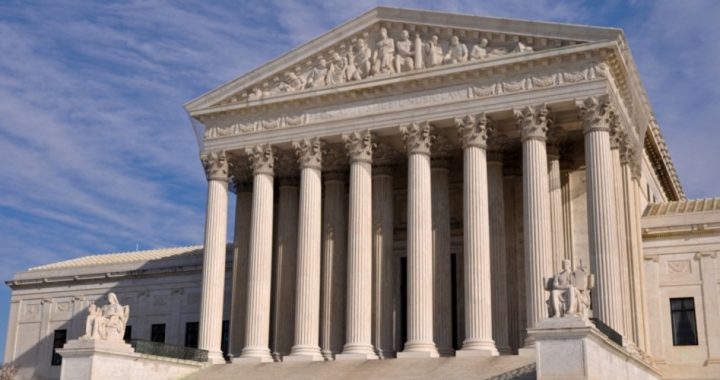
The Supreme Court on December 4 granted a stay of the October rulings by two lower courts that had blocked the Trump administration from enforcing its suspension on travel from six majority-Muslim countries. The San Francisco-based NInth Circuit Court of Appeals and a federal district court in Maryland ruled in October that the Trump administration could block nationals from countries named in Trump’s September 24 proclamation — Iran, Libya, Syria, Yemen, Somalia, and Chad — only if they lacked a bona fide relationship with a person or entity in the United States.
The High Court’s ruling was made by a vote of 7-2, with Justices Ruth Bader Ginsburg and Sonia Sotomayor stating they would deny the application.
During a press gaggle aboard Air Force One on December 4, Deputy White House Press Secretary Hogan Gidley released the following statement about the ruling:
We are not surprised by today’s Supreme Court decision permitting immediate enforcement of the President’s proclamation limiting travel from countries presenting heightened risks of terrorism. The proclamation is lawful and essential to protecting our homeland. We look forward to presenting a fuller defense of the proclamation as the pending cases work their way through the courts.
The High Court’s decision stays the previous lower court rulings against the administration until a ruling is made on the administration’s appeal in the United States Court of Appeals for the Fourth Circuit in Richmond, Virginia. The decision states: “In light of its decision to consider the case on an expedited basis, we expect that the Court of Appeals will render its decision with appropriate dispatch.”
Quick resolutions by the appellate courts would allow the Supreme Court to hear and decide the issue during the present term, by the end of June. Both the Ninth U.S. Circuit Court of Appeals and the Fourth U.S. Circuit Court of will be holding arguments on the legality of the ban this week.
A Washington Post report quoted David Levine, a University of California Hastings law school professor, who said that by allowing the ban to take effect just days before the appeals court arguments, the justices were signaling their view.
“I think it’s tipping the hand of the Supreme Court,” Levine said. “It suggests that from their understanding, the government is more likely to prevail on the merits than we might have thought.”
The Department of Homeland Security’s acting press secretary, Tyler Q. Houlton, made the following statement about the decision: “We are pleased that the Supreme Court has agreed to allow us to fulfill this most vital mission performed by any sovereign nation. DHS will continue to fully implement the President’s robust and Constitutional counterterrorism agenda in accordance with the law.”
President Trump issued three separate orders suspending the admission of nationals of certain countries since taking office in January, with each of them being challenged by different federal judges. The first order, issued on January 27, was entitled “Protecting the Nation from Foreign Terrorist Entry into the United States.” Among the provisions that Trump made in that order was a “Suspension of Issuance of Visas and Other Immigration Benefits to Nationals of Countries of Particular Concern.” Interestingly, since much has been written in news stories about Trump’s “ban on Muslims” entering the country, only one nation, war-ravaged Syria, was specifically mentioned in that executive order.
The mass media has made much of Trump’s 90-day suspension of entry into the United States from seven predominantly Muslim countries — Iraq, Libya, Somalia, Sudan, Syria, Yemen, and Iran — without mentioning that that particular group of countries originates with H.R. 158, the Visa Waiver Program Improvement and Terrorist Travel Prevention Act of 2015, signed into law by former President Obama on December 18, 2015, as part of the Omnibus Appropriations Act of FY2016.
This alleged “anti-Muslim” bias was the basis of most, if not all, of the judicial decisions attempting to stop the Trump administration’s suspension of migration from countries where terrorism is rampant. The first of these occurred on January 28, when U.S. District Court Judge Ann Donnelly ruled in favor of a petition filed by the American Civil Liberties Union (ACLU) on behalf of two Iraqi men who were detained at John F. Kennedy International Airport the previous day under the first executive order. Subsequently, judges in other federal district courts in Massachusetts, Virginia, and Washington issued similar rulings.
Following that court ruling, on March 6, Trump signed an executive order “to protect the Nation from terrorist activities by foreign nationals admitted to the United States.” The new order differed from the January 27 order and dropped Iraq from the nations listed. In place of the suspension, Iraq agreed to “increase cooperation with the US government on the vetting of its citizens applying for a visa to travel to the United States.”
Despite the changes, two federal judges — the first in Hawaii and the second in Maryland — issued rulings blocking all or substantial provisions of the amended March 6 executive order. After that, a seesaw judicial battle followed, with some courts continuing to strike down the Trump “travel ban,” and other agreeing to uphold it. The case eventually went to the Supreme Court, where Associate Justice Anthony Kennedy issued an order on September 11 that stayed a September 7 ruling by the U.S. Appeals Court for the Ninth Circuit that said that the Trump administration can’t prevent grandparents and other family members of citizens and legal residents from coming to the United States from six mainly Muslim countries with a strong terrorist presence.
On September 24, just hours before his previous travel ban was set to expire, Trump signed a proclamation limiting the immigrant and nonimmigrant entry into the United States from eight countries. The new proclamation continued the suspension on immigration from five of the six countries in the previous ban: Iran, Libya, Syria, Yemen, and Somalia. It also added three new countries to the list: Chad, North Korea, and Venezuela.
The Supreme Court’s December 4 stay continues a pattern where the High Court has tended to regard the Trump administration’s efforts to prevent potential terrorist from entering the country more favorably than some of the lower federal courts. If Professor Levine’s statement is correct, and the Supreme Court’s ruling amounts to tipping its hand about how it will rule when future cases are sent to it from the appeals courts, then there is cause for optimism that the administration’s efforts will eventually prevail.
Related articles:
Trump Proclaims New Travel Ban, Adds Three New Countries, Including North Korea
Supreme Court Justice Stays Appeals Court Ruling Limiting Trump Travel Ban
Trump Travel Ban Unconstitutional? But Obama, Bush, Carter Travel Bans Constitutional?
Hawaii’s Judge Watson Loosens Trump Travel Ban
Supreme Court Allows Most of Trump Travel Ban to Proceed, Will Hear Case in Fall
Ninth Circuit Court Rules Against Travel Ban, but Trump Fires Back
Trump’s DOJ Submitted “Watered Down” Version of His Travel Ban to Supreme Court
Trump Administration Asks SCOTUS to Rule on “Travel Ban”
9th Circuit Court Considers Appeal of Judge’s Order Against Trump Travel Ban
Federal Judge Upholds Trump Travel Ban Blocked by Other Courts
Federal Judges Again Block Trump Travel Ban From Nations With Terrorist Ties
Trump Signs New Immigration Executive Order
Judge Grants Stay to Bar Trump DHS From Deporting Aliens From Seven Nations of Concern
Trump’s Order Suspending Refugee Program: Racism or Balanced National Security?
Trump Executive Order to Ban Nationals of “Countries of Particular Concern”



